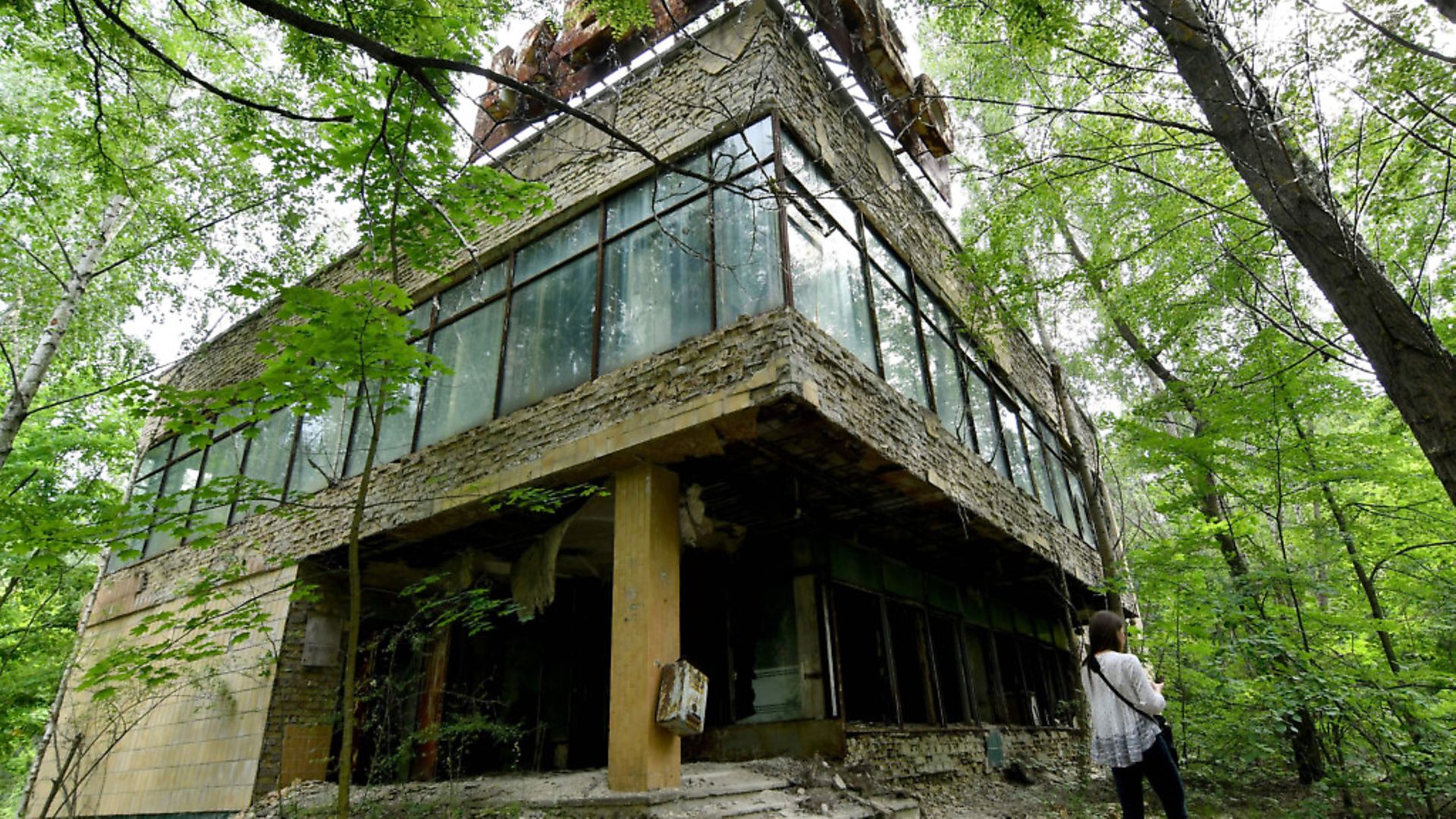
The area around the Chernobyl nuclear plant is enjoying a tourism boom in the wake of the hit TV series on the disaster. Garth Cartwright went along to join the visitors.
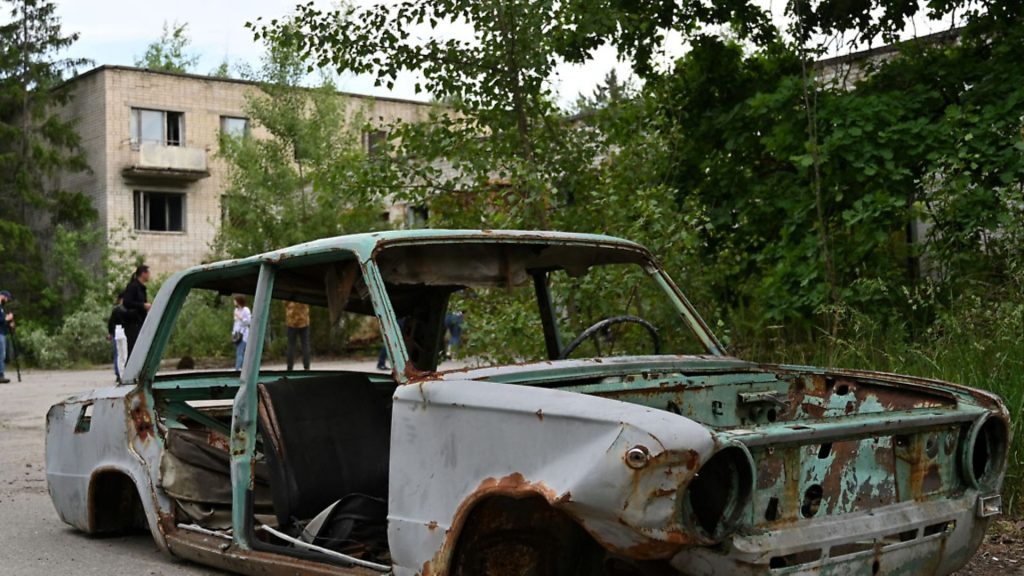
Standing outside a decaying amusement park in the ghost town of Pripyat, the settlement built in 1970 to house the 50,000-strong community who serviced the Chernobyl nuclear reactors, is an eerie experience. Our guide’s Geiger counter beeps with increasing excitement as she swings it over toxic soil while explaining how attempts to “wash” radiation residue from the buildings has made the surrounding earth ever more contaminated. “So don’t ever consider picking the apples or mushrooms you see growing wild.”
Taking a day trip to Chernobyl has been possible since 2000. Initially, it appealed largely to those attracted to ‘disaster tourism’ – and the ongoing separatist conflict in east Ukraine and often violent uprisings against different presidents have ensured Ukraine is not yet an East European hotspot for visitors – but increased interest in environmental issues and the Emmy-winning HBO series Chernobyl have steadily increased numbers. “Last year 7,000 people visited Chernobyl,” says our guide, Irena. “We reached 7,500 by the end of August this year and then the first Saturday this September saw 1,300 tourists visiting. Which is too much.”
I visited on a Wednesday, mid-September, noting only a handful of other mini-buses and perhaps three or four cars carrying those who prefer to pay considerably more for a private tour. I’m guessing less than one hundred visitors on this dry, mild day. Our mini-bus of 17 tourists was largely drawn from US and UK visitors – plus an Indian, a Japanese, an East German (he recalled being in the army at the time and hearing nothing but rumours of the disaster) and possibly a few other nationalities. Brits and Poles make up the biggest visitor numbers, noted Irena, who then admitted to being completely unaware that Chernobyl tourism existed until she, having finished university, was directed towards the job three years ago.
A day trip in a group costs $100 US – now almost £100 thanks to those buccaneering Brexiteers – and includes transport from and to Kiev, a guide, Geiger counters and a device worn around the neck that supposedly measures your radioactivity status. And lunch (pork, of course). Book your Chernobyl trip online at least ten days before the chosen date and, while doing so, provide passport info (and carry your passport with you for the trip – it will be checked several times).
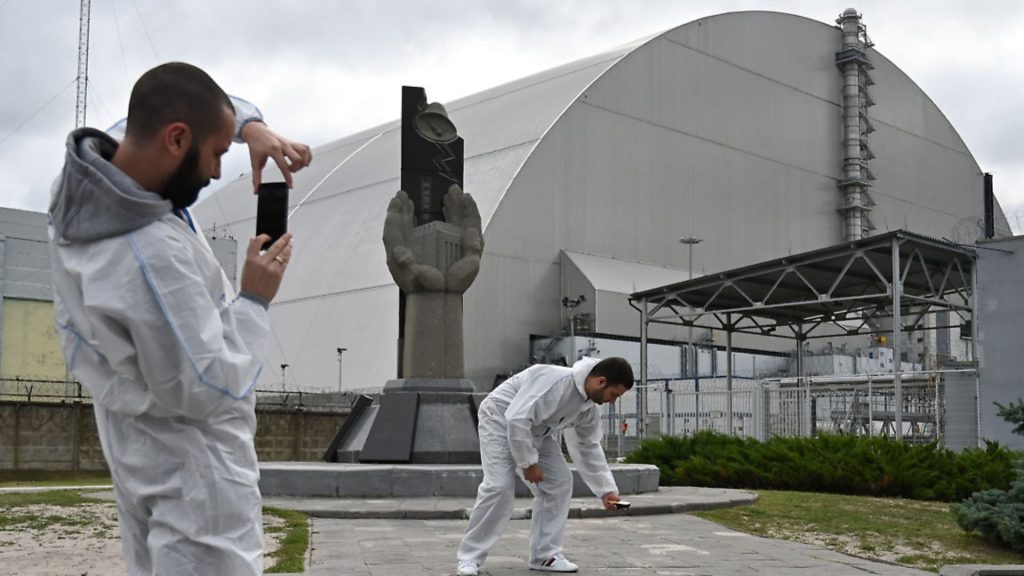
Quite why the Ukrainian government demands each visitor’s passport information I’m unsure, but entering and exiting the exclusion zone is akin to visiting a conflict region: Passports are checked at different military posts, no photography / filming is allowed at these check-points, forms must be filled in (ensuring the visitor will not find the government liable for anything “detrimental” that occurs) and, just before exiting, you get a screening to see if you are actively radioactive. I doubt whether this elemental test is anything more than designed to add a frisson of “I survived!” to us thrill-seekers but it ensures that being in the zone – and Irena’s constant reference to “the zone” adds a certain sci-fi lustre to proceedings – is certainly not dull. At one check-point Irena returns to the mini-bus and nonchalantly tells us that the soldiers, “have caught three illegals.” I felt like I’d stepped into the Hunger Games.
Here the “illegals” are those who determine to enter the zone without having any authorisation to do so. Irena states that, where once they were looters coming to strip properties, today’s illegals are most commonly youths who want to film themselves “doing Chernobyl” for YouTube “exclusives”. She also observes how, on occasion, a tour group member will duck into the foliage for a couple of minutes so as to film themselves in an attempt to make it appear they’re exploring Chernobyl solo. Finally, she notes that, as it’s a long, long trek from the zone to the outer-lying village where a public bus service to Kiev exists, many of these wannabe social media stars are happy to get caught so to ensure they receive a military escort out. Although the fine they then find levied may deflate exactly how enthusiastic they remain about such shenanigans.
Those who see breaking into the zone as one big adventure represent the extreme end of disaster tourism – once called “thrill-seekers”, they visit locations simply because they carry a certain wow factor amongst their friends and associates and can now command vast followings via social media as they vie for attention with Red Bull-sponsored extreme sports.
Visiting Chernobyl isn’t high on the risk factor – the more hardcore will attempt to enter Afghanistan and other conflict zones and thus sometimes end up joining journalists and photographers amongst the casualties. But, are we who register and enter legally, really any different? We’re still here to view the site of a historic disaster and take a few photos to post on Facebook or show the folks back home: A retired American couple who were part of our tour played out an unintentionally comic scenario with the husband having to stand in front of every site we visited (arm often pointed at whatever he stood near) while his wife avidly snapped away.
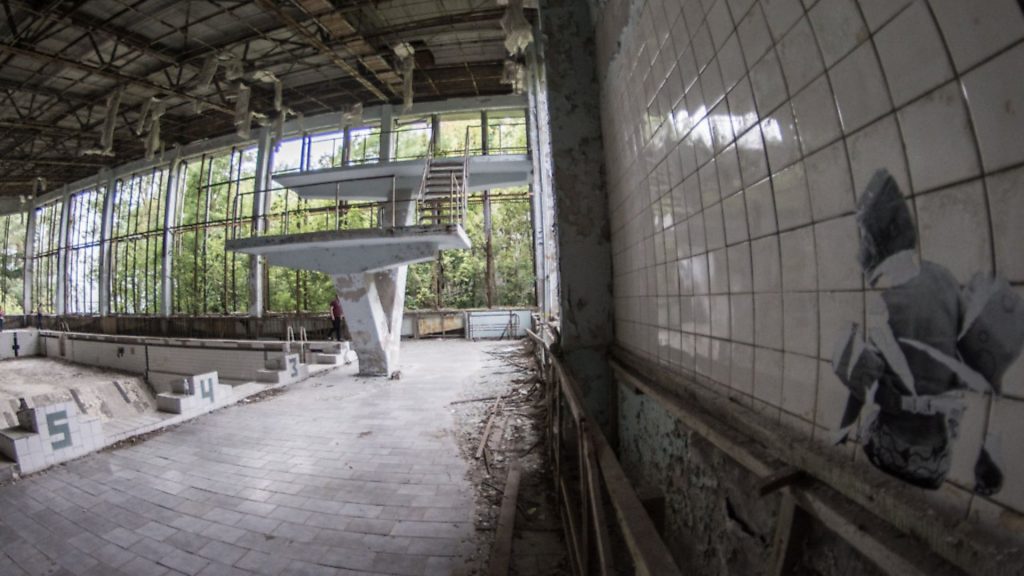
Noting their enthusiasm, Irena mentioned how they were preferable to another American couple who, at the first stop on the tour, when the Geiger counter began to beep, panicked and demanded to be returned to Kiev. So, no, obviously we’re just slightly less adrenaline-fuelled participants. But the tour is well thought out and executed: There’s no ‘scare factor’ or anti-Russian propaganda and lots of background on what happened and what followed over the decades.
The destinations we stopped at are chosen for a mix of photogenic locations – most potent is Pripyat, now a ghost town with a decaying fun fair and ruined Olympic-sized swimming pool alongside apartment blocks that have been left to crumble – and historic markers.
I certainly learnt a lot: The fact that staggered me was how Chernobyl’s three other nuclear reactors continued to produce electricity after the disaster. Ukraine was so dependent on the power the stations produced that it could not afford to shut them down. Reactors 1,2 and 3 were eventually decommissioned in 1991 (after a fire damaged reactor 2), 1996 and 2000. Which means that those who worked at those three plants must have been exposed to dangerous amounts of radiation.
Exactly how dangerous is for the scientists to discuss: Irena mentioned going for a test after two years as a guide and was found to be healthy. Yet we were still instructed not to eat or drink when outside the minibus – even food we had brought with us from Kiev – so giving a sense that even the air might contain dangerous toxins.
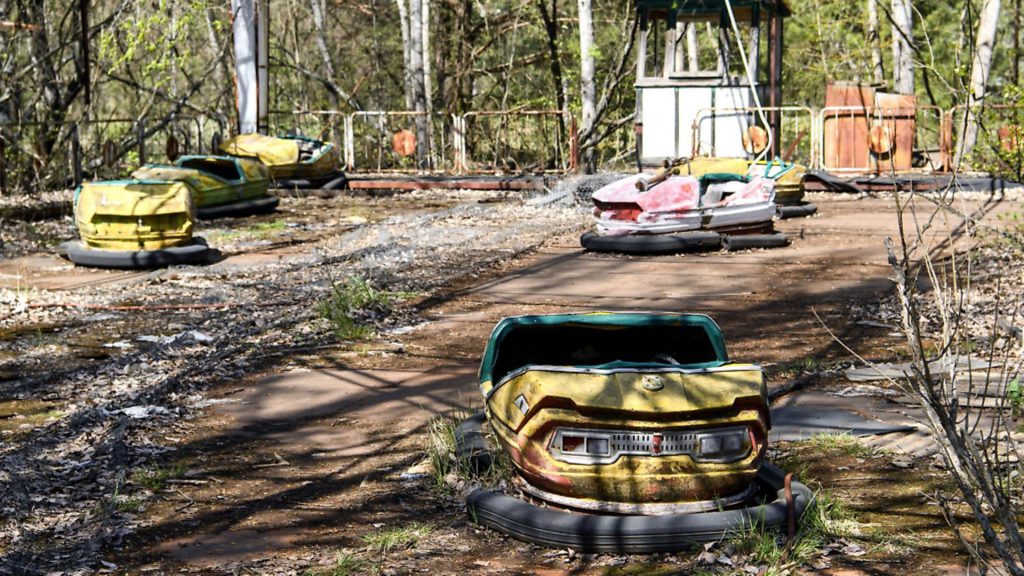
What did I, as a legal with no YouTube following, take from my trip to the site of the world’s worst nuclear accident? Many things. Having watched the television series (excellent) only days before I left for Kiev and read up, I knew the historic background to the disaster. But travelling through and walking amongst this cursed land truly puts things in perspective: Upon getting close up to Reactor 4 I was stung by the realisation of just how close the three other nuclear reactors at Chernobyl were – only a thick concrete wall isolated Reactor 3 from 4. Standing in the autumn sunshine and looking at the site emphasised how things could have been so much worse.
The original Soviet ‘sarcophagus’ built to encompass Reactor 4 had deteriorated so badly by 1996 that a new replacement was needed to cover the 200 tons of radioactive corium lava, 30 tons of highly contaminated dust and 16 tons of uranium and plutonium. In its place was built the New Safe Confinement (NSC), a giant steel shed, financed by the European Bank for Reconstruction and Development and largely designed and built by a combined French and British effort.
The NSC was slid into position in November 2016 and is both a remarkable feat of engineering and a symbol of how Europe can come together to resolve crisis situations – one of lessons I drew from my visit. Another was that the disaster was made possible by the Soviet government’s failure to develop a civil society where people could legitimately and without fear of punishment voice concerns and make complaints. The men held responsible for this nuclear disaster were bureaucrats interested with advancing their careers through pleasing those in command. When challenged by the workers at the nuclear power plant they used threats to override any concerns. And once the explosion had taken place they tried to employ a mix of intimidation and lies to covers for their terrible mismanagement.
Chernobyl came about not simply because a safety test was terribly mismanaged; no, it came about because a culture of lies, corruption, ignorance, cost-cutting, unchallenged propaganda and total disregard for the welfare of ordinary people existed.
A culture of fear had also created a society where truth was often passed over in preference for the more acceptable lie. This meant a man-made disaster of the kind never seen before could – for at least the first few days in the case of Chernobyl (concerning the poisoning of the Aral Sea in Central Asia, the lies and ecological destruction went on for decades) – be passed off as a minor incident: Those who knew what had happened at Chernobyl were reluctant to report as much, so that even the Soviet president Mikhail Gorbachev was, initially, mislead. The residents of Pripyat and the surrounding villages were lied to throughout (initially told they only had to leave their homes for two days).
The resulting climate of mistrust that stemmed from all this fed into Soviet, and specifically Ukrainian, society. Gorbachev himself noted that the collapse of the USSR was initiated by the disaster and Moscow’s lies about the radioactive explosion fuelled Ukraine’s independence movement. The toxic consequences have outlasted the end of the Soviet Union and the birth of an independent Ukraine and the country remains extremely dysfunctional some 33 years on from the disaster.
Back in Kiev, after my visit to Chernobyl, I discovered that another Ukrainian explosion had occurred while I was in the zone. This new one appeared very toxic but at least it was non-nuclear: That afternoon the White House had unleashed the transcript of the phone conversation between presidents’ Trump and Zelensky, the resulting furore fuelling the Democrats impeachment action against the US president.
Ukrainians appeared largely bemused by the ‘crisis’ and Trump’s initial threat to withhold military aid to Ukraine – they’re aware of both how much their nation relies on the largesse of the US and EU and Trump’s enthusiasm for the nation’s arch enemy: Vladimir Putin. It was a reminder, though, that events in this country have the potential for profound and lasting consequences felt around the rest of the world.









